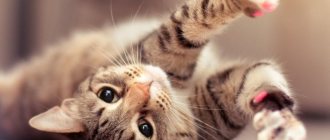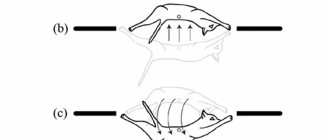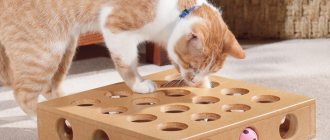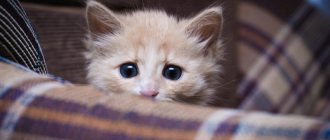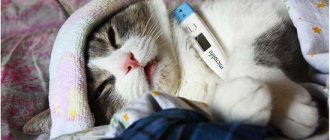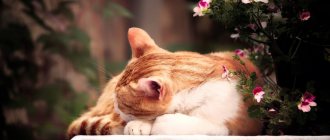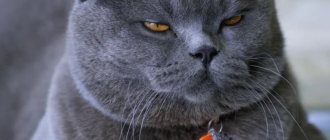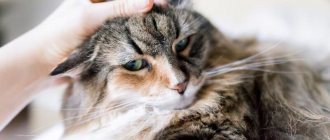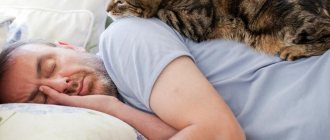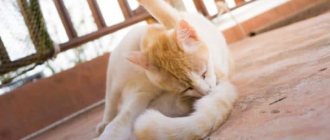Hind limb failure is most often observed in middle-aged and older animals, but can also occur in young animals. In most cases, this is a sign of quite serious pathologies that can be fatal if ignored. The loss of support in the legs may not occur suddenly, but at first the owner most often does not notice that the pet is slightly dragging its paws or is reluctant to move. Therefore, in most cases, animal owners turn to the veterinarian with complaints of sudden failure of the hind limbs.
To quickly solve this problem, which definitely complicates the animal’s life, you need to understand the reasons that provoked the pathology. In most cases, with prompt treatment, the function of the hind legs can be restored, so it is necessary to know the factors that can cause this impairment of supporting ability.
Causes of cerebellar ataxia
The main cause of impaired motor coordination in cats is infections that affect the central nervous system and brain. Most often, ataxia develops against the background of panleukopenia.
Loss of coordination is the main sign of pathology
Cerebellar ataxia in cats is a hereditary disease with a genetic predisposition or develops as a congenital form. It can appear as a result of an intrauterine developmental disorder in kittens.
Also reasons may be:
- traumatic brain injuries;
- cerebral edema;
- inflammatory processes;
- damage to the inner ear due to otitis media;
- neuritis of the craniofacial nerve;
- tumors.
Veterinarians include hernias between the vertebrae and spinal cord injuries as possible causes of incoordination in cats.
Otitis in a cat
Moving around the apartment
With irreversible changes in the spinal cord, some cats can move around the apartment with a spinal gait, i.e. The hind legs walk reflexively and are not controlled by the brain. Of course, the back half of the cat moves awkwardly, with a strong amplitude, but this is not so important, because the pet walks on its own. With a spinal gait, the hind legs are rarely injured, but cat owners should be on the alert, and if abrasions are detected, they should put socks on the paws.
If this gait does not work out for your pet, it will still move deftly and quickly on its forelimbs. Advice to all owners of disabled cats - do not help their pets move. Don't do the animal a disservice. If you see that your pet is trying to climb onto the sofa, do not interfere. Let him do it himself, without outside help. This is the only way to achieve active behavior and the development of new skills in paralyzed cats.
It is extremely important to play with a disabled cat as with a normal pet. You can equip a multi-tiered house through which the animal will move and crawl.
Some owners buy a walker or stroller for their four-legged friend. These devices are mainly needed by dogs, but they are also used for cats. You can put a walker on your pet during active games. But during rest it is better to take them off. In general, everything here is individual. Some cats happily accept strollers and walkers, while some, on the contrary, do not allow them to be put on.
General group of symptoms for all types
The disease has species-typical and generally similar symptoms. The different symptoms depend on the causes. All types of pathology are characterized by:
- the cat holds its head atypically, it can tilt it to the side or lower it down;
- a staggering gait is observed, the animal loses coordination, the cat can walk, raising its hind legs high.
Epilepsy in cats: symptoms, treatment, how to stop seizures
If the animal's spinal cord is damaged, it will experience pain when walking. Such cats try to hide in a quiet place and move less.
Attention! In severe forms, paralysis of the hind limbs can develop in cats.
With cerebellar ataxia, tremor occurs when running or walking. The kitten will often tremble, and most often the trembling is noticeable only in the back of the body. The cat also has dilated pupils and poor coordination.
If the vestibular apparatus is affected, the cat will suffer from severe headaches. Such animals constantly meow, hide in the corner, pressing their foreheads against the wall.
Hind limb paralysis
How do cats fall?
Starting a Cat Fall
A cat that starts falling paws up will turn in the air so that it lands on all four paws. The excellent vestibular apparatus of the cat's inner ear allows her to instantly orient herself and figure out what position she is in in relation to the ground and what needs to be done to take the desired position. This process is as precise as if the cat had a gyroscope inside. When a cat lands, the impact of the fall is distributed evenly across all four paws. In addition, during flight, the cat's paws are bent, so when they touch the ground, the force of the impact is not transferred directly to brittle bones, but is distributed between more elastic muscles and joints.
Interesting: Platypus - where it lives, lifestyle, nutrition, photos and videos
Mid fall cat
Fun fact: A cat's inner ear contains an excellent balance mechanism that allows her to turn in the air when she falls so she can land on all four paws.
There is another surprising fact about cat falls: the higher the height a cat falls from, the more likely it is to survive. According to statistics from New York veterinarians, 10 percent of cats that fell from a height of 2 to 6 floors died. But only 5 percent of cats that fell from 7 to 32 stories did not survive the fall. What's the matter? During the fall of a body, it receives acceleration, that is, the longer the body falls, the greater its speed becomes. The acceleration of free fall is the same for all physical bodies and does not depend on their mass; it is 36 kilometers per hour in one second, that is, the speed of a body during a fall increases by 36 kilometers per hour in one second. This means that if the fall begins from a state of rest, then after a few seconds of flight the speed of the fall will reach 150 - 200 kilometers per hour.
The end of the fall
If there were no atmosphere and bodies fell in airless space, then two bodies would hit the ground at the same time, even if one of them is a feather and the other is a refrigerator. But when falling in the atmosphere, the picture changes. When a body flies a certain distance in the air, it reaches, as physicists say, a terminal speed, because the friction (resistance) of the air tends to slow down its fall. How much the force of air friction can slow down the fall of a body depends on the mass and size: the fall is slowed down more strongly with a small mass and large dimensions. Returning to real life, we can say that a person of average height and weight, having flown 6 floors, will have a falling speed of about 190 kilometers per hour upon contact with the ground. A cat in the same situation will only have a speed of 85 kilometers per hour.
Interesting: Lions
